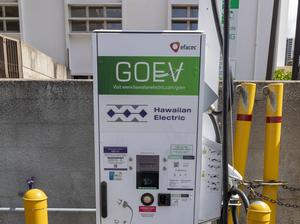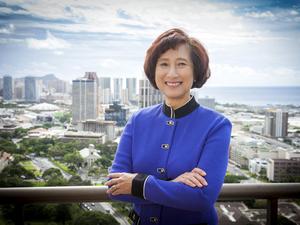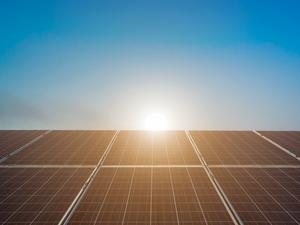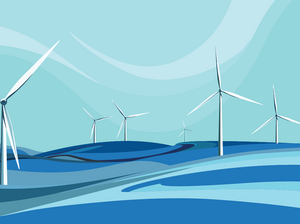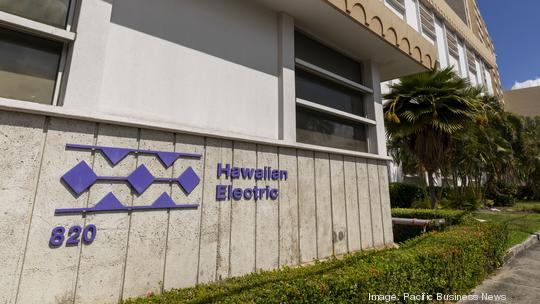
Hawaii environmental advocacy groups reacted with appreciation Friday to a pledge from Hawaiian Electric Co. to reduce its carbon emissions from power generation by 70% by 2030, as relative to 2005 levels, while describing the commitment as ambitious.
The announcement coincided with the COP26 global climate summit in Glasgow, Scotland.
The U.S. and other nations have committed to attempt to hold global warming to 1.5 degrees Celsius to avoid some of the worst threats posed by climate change.
“The runway is getting shorter all the time,” Scott Seu, president and CEO of HECO and the future president and CEO of parent company Hawaiian Electric Industries, said in a statement. “The 2030 goal is a stretch for us, but we have to commit to bold actions in the next few years if we’re to have any hope of stalling climate change. We want to look back at this time and know we did all we could do to stop things from getting worse.”
Blue Planet Foundation and Ulupono Initiative were among those to weigh in on the announcement.
Melissa Miyashiro, Blue Planet executive director, emailed to Pacific Business News, "With this announcement, Hawaiian Electric is publicly declaring and recognizing the urgency of climate change and the central leadership role the utility plays in helping Hawaii accelerate progress toward rapid carbon emissions reductions.
"As a community and a planet, we want and need the utility to succeed in making these commitments a reality. We believe that Hawaiian Electric can achieve it. But that doesn't mean it will be easy. It will require new conversations, refreshed approaches, and creative collaboration — from all of us.
"We hope today's announcement inspires other businesses and leaders to boldly commit to action on climate change. Emissions reductions at this scale should be a goal we share economy-wide. Collectively, we can and must figure out how to rise to the challenge to get there."
Murray Clay, president of Ulupono Initiative, issued PBN a statement: “Although every sector impacts our path to decarbonization, few are as impactful as the energy sector. Hawaiian Electric’s goal to reduce 70% of its carbon emissions by 2030 demonstrates the utility’s understanding of this reality, its responsibility, and commitment to both national and state decarbonization targets. Ulupono Initiative commends many of the actions described by Hawaiian Electric to achieve this ambitious goal, as they reaffirm opportunities to improve its overall performance while also delivering more ‘climate value’ to its customers and the broader island community through reducing emissions today instead of a decade from now.”
Ulalia Woodside, executive director of The Nature Conservancy, Hawaii and Palmyra chapter, said in HECO's release, “In Hawaii, we can and should be utilizing nature-based solutions to tackle climate change. It is absolutely right that Hawaiian Electric is looking at alternative energy sources. These efforts should be contemplated with strong and robust community input and consent, informed by the best science, and done in a way that preserves native habitats and species.”
HECO previously committed to the state's plan for net zero carbon emissions by 2045.
The 2030 target, however, is coming up much more rapidly, with a little over eight years to hit the mark by that year. There is a U.S. target of 50% carbon reductions by 2030.
According to HECO, other sectors of the state economy like transportation, agriculture, construction and industry would still have to cut emissions by at least 40% by 2030 to meet the U.S. target.
HECO, which oversees the power grids on Oahu, Hawaii Island, Maui, Molokai and Lanai, laid out seven primary ways it plans to reduce its emissions:
- Shutting down the state's last coal plants in 2022
- Adding nearly 50,000 rooftop solar systems to the 90,000 currently on its grids
- Retiring at least six fossil-fueled generating units and significantly reducing the use of others as new renewable resources come online
- Adding renewable energy projects capable of generating a total of at least 1 gigawatt, including community-based renewable energy
- Using more grid-scale and customer-owned energy storage
- Expanding geothermal resources
- Creating innovative programs that provide customers incentives for using clean, lower- cost energy at certain times of the day and using less fossil-fueled energy at night
By 2030, HECO said it plans to have nearly 100% renewable power in its renewable portfolio standard on Hawaii Island and in Maui County, and an overall RPS of over 70%. It said progress beyond that includes projected future technologies along with expansion of solar, wind, geothermal, hydroelectric and biofuels. New forms of carbon reduction may involve offshore wind, green hydrogen, wave energy and carbon capture technologies.
Nuclear, natural gas and large-scale hydropower are not seen as viable options by HECO. And unlike other states, it cannot import power from neighboring states.
“Hawaiian Electric has a critical role in reducing carbon emissions this decade in Hawaii, especially in transportation, so this new goal is significant,” said Gov. David Ige, who is attending COP26. “The COP26 meetings made absolutely clear that even though Hawaii has done a lot, we have to do even more. Working together, Hawaii can do its part to hit these targets. We are not willing to wait for the rest of the planet to do what we know is in our community’s best interest.”
One renewable power project as part of HECO's long-term plans, the 60-megawatt Puako Solar project on Hawaii Island, was recently scrapped while citing rising interconnection costs and supply chain issues. Three renewables projects from AES Corp. on Oahu, Maui and Hawaii Island have experienced delays due to force majeure.

